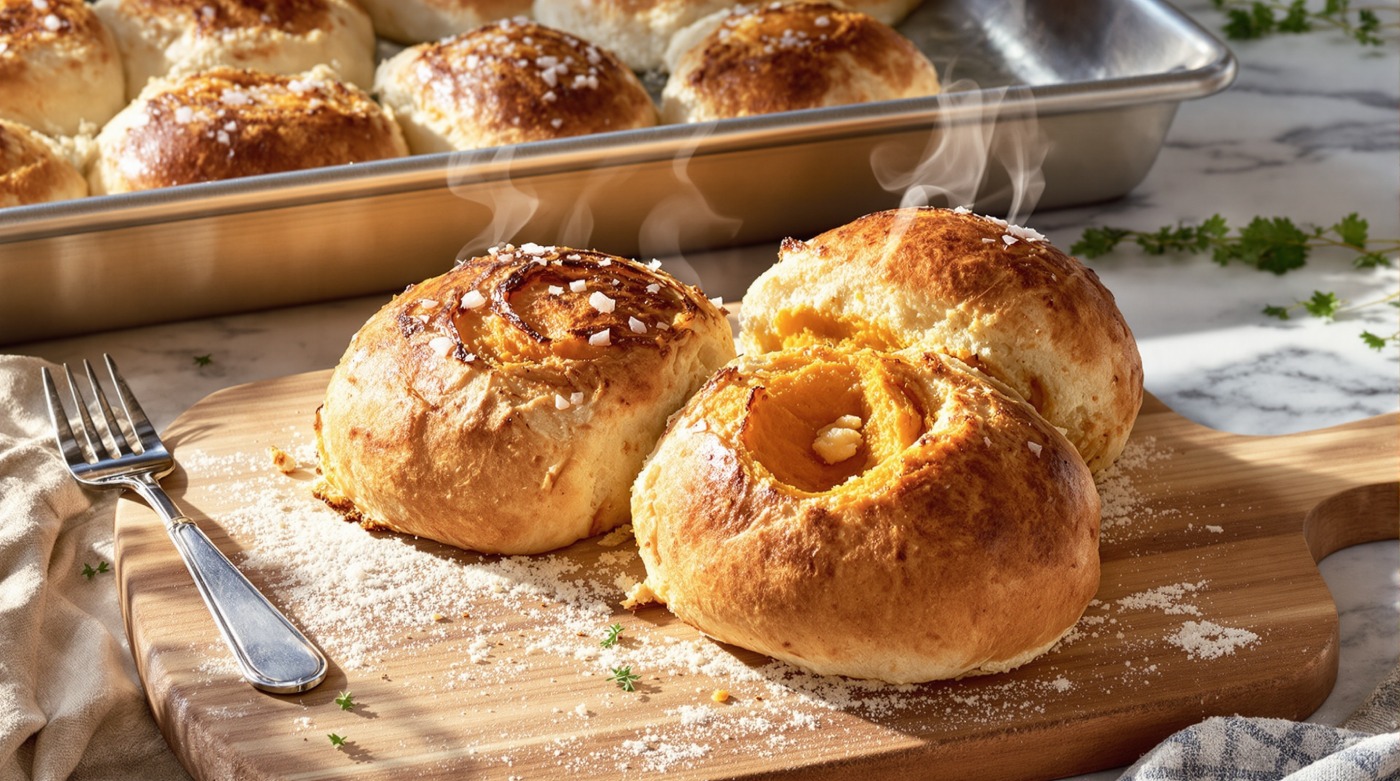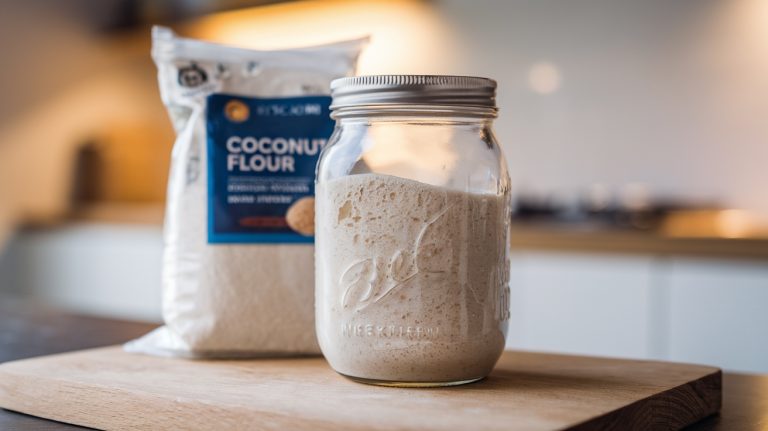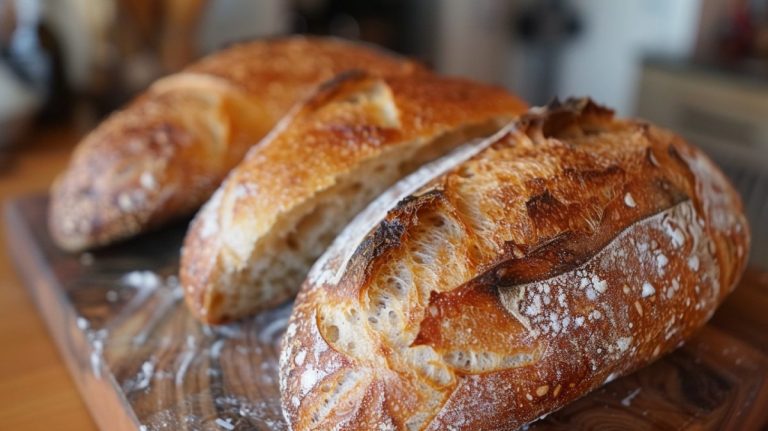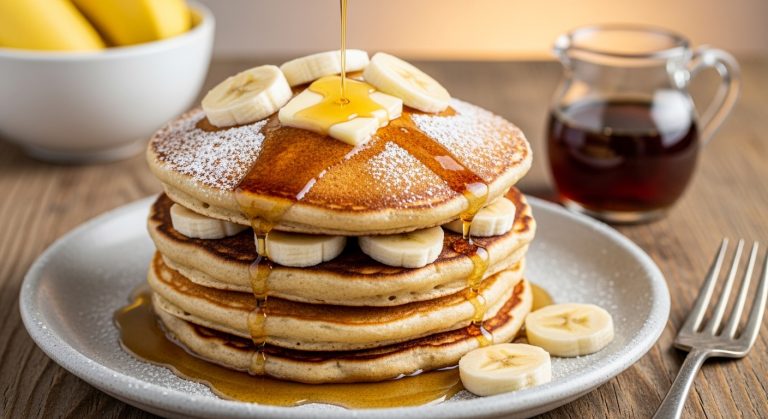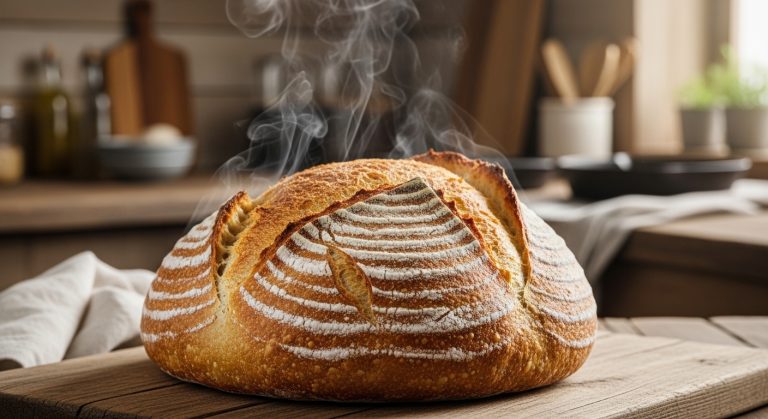Sourdough Sweet Potato Rolls: Golden Crumbs, Pure Comfort
Immerse yourself in making sourdough sweet potato rolls with gusto! Start by gathering 1½ cups of mashed sweet potato, ½ cup active sourdough starter, 300-434g bread flour, butter, milk, eggs, honey, and salt.
Prepare a silky puree, mix it with wet ingredients, then combine with dry for a soft dough. Knead well, ferment, shape, proof, and bake at 350°F for 22-25 minutes until golden. Stick around to uncover deeper secrets of this delightful treat.
Key Takeaways
- Sourdough sweet potato rolls combine 1½ cups mashed sweet potato with ½ to 1 cup active sourdough starter for unique flavor.
- Prepare sweet potato puree by baking, steaming, or pressure cooking until fork-tender, then blend until smooth.
- Mix dough using a liquid-first approach, knead for gluten development, and bulk ferment at 75-80°F for 5-6 hours.
- Shape dough into 12-16 equal pieces (63-70g each), proof at 78°F for 3-4 hours until doubled in size.
- Bake at 350-400°F for 22-25 minutes, brush with butter and honey, then cool for 30 minutes before serving.
Gathering Your Ingredients
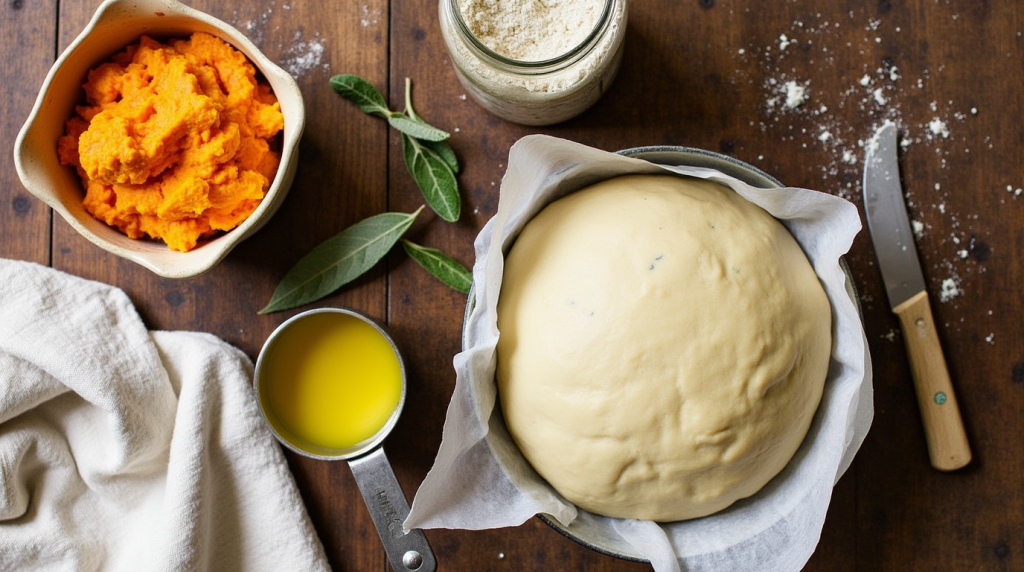
Let’s plunge into the heart of making Sourdough Sweet Potato Rolls by gathering your ingredients with care and precision.
Grab 1½ cups of mashed sweet potato, ensuring it’s ready for use. Measure out ½ to 1 cup of active sourdough starter or prepare a levain with 35g each of starter, flour, and water. Ensure your starter is active and fed to guarantee a good rise in your rolls.
Weigh 300–434g of bread flour, and don’t skimp on quality. Soften 6–8 tablespoons of unsalted butter, and warm ¾ to ½ cup of whole milk.
Add 1–2 eggs for richness, ¼ cup honey for sweetness, and 9–12g kosher salt for balance. If you’re boosting rise, include 3g instant yeast. Remember to have all-purpose flour on hand as a versatile option for adjusting dough consistency.
Finally, enhance flavor with 2 tablespoons chopped fresh sage.
Preparing the Sweet Potato Puree
Now that you’ve gathered your ingredients, it’s time to focus on crafting the perfect sweet potato puree for your Sourdough Sweet Potato Rolls.
Start by choosing your cooking method—bake unpeeled sweet potatoes at 400°F for 60-90 minutes, steam cubed pieces for 10-15 minutes, or pressure cook in an Instant Pot for 5 minutes. Confirm they’re fork-tender, then cool slightly.
Choose your method to cook sweet potatoes—bake at 400°F for 60-90 minutes, steam for 10-15 minutes, or pressure cook for 5 minutes.
Blend using a food processor or masher until silky smooth, scraping down sides as needed. If desired, add a splash of milk for creaminess. Remember to ensure uniform size for even cooking when cutting or selecting sweet potatoes.
Store your vibrant, nutrient-packed puree in an airtight container in the fridge for up to a week or freeze for later. If you’re using a sourdough starter in this recipe, consider incorporating any discarded starter to enhance the flavor and reduce waste.
Mixing the Dough
After preparing your sweet potato puree, plunge into the heart of crafting your Sourdough Sweet Potato Rolls by mixing the dough with precision and care.
Start with the liquid-first approach—blend your cooled sweet potato puree (300-400g), milk, and egg with your active starter for even distribution. Add brown sugar to this wet mix, ensuring a smooth base.
Next, combine your dry ingredients separately, mixing salt into the flour to protect the yeast. Remember to incorporate the tangzhong mixture at this stage for that pillowy texture.
Use a dough whisk or stand mixer paddle to merge wet and dry, mixing for 1-2 minutes until just combined. If the dough’s sticky, don’t worry—grab a bench scraper to manage it. For accurate measurements of your ingredients, consider using a digital baking scale to ensure consistent dough hydration.
Adjust flour based on the puree’s moisture.
Kneading and Bulk Fermentation
Hey, let’s get hands-on with kneading your sourdough sweet potato rolls, focusing on a gentle yet firm technique to build that essential gluten structure in just 30-60 seconds or longer with a stand mixer.
Keep a sharp eye on bulk fermentation timing, aiming for a 75% volume increase at 68-75°F to guarantee perfect rise and flavor. Remember, allowing the dough to rest for 5-6 hours during this stage, as recommended, ensures the sourdough starter fully develops the dough’s unique tangy taste. During this process, perform stretches and folds to enhance dough strength and ensure even gas distribution.
For gluten development, don’t skimp on testing with the windowpane method to confirm your dough’s ready for the next step.
Kneading Technique Essentials
While mastering sourdough sweet potato rolls demands attention to detail, kneading stands as the cornerstone of creating a flawless texture. You’ve gotta commit 8-10 minutes to active manipulation, using techniques like slap & fold or tear & stretch to build a strong gluten network.
Lean into the dough with forearm pressure, and don’t shy away from a dough scraper to manage stickiness. Keep your hands wet and surface lightly misted to avoid tearing.
Remember, the dough will transform significantly within 15 to 20 minutes of kneading, becoming more cohesive and stretchy dough transforms significantly. Additionally, maintaining a consistent dough temperature around 75°F (24°C) is crucial for optimal yeast performance during this process.
Check out these essentials for killer kneading:
| Technique | Key Benefit |
|---|---|
| Slap & Fold | Boosts gluten development |
| Tear & Stretch | Guarantees even gluten alignment |
| Body Weight Pressure | Optimizes gluten network |
| Dough Scraper Use | Prevents excess flour addition |
| Windowpane Test | Confirms gluten maturity |
Bulk Fermentation Timing
Now that you’ve nailed the kneading, let’s zero in on bulk fermentation timing for your sourdough sweet potato rolls. This stage is essential for that perfect rise!
At 78°F, expect 5-6 hours for the dough to double with a domed surface. Cooler kitchens at 68°F stretch this to 8-9 hours, while 72-75°F takes 3.5-4 hours with stretch-and-folds. Performing regular stretch-and-folds during this period can strengthen the dough and improve its structure for better rolls.
Watch for a slight wobble when shaken and a slow spring-back when pressed—clear signs it’s ready. If life’s busy, refrigerate overnight for 12-48 hours to enhance flavor and flexibility. Remember, the dough’s texture can benefit from this cold fermentation enhancing tangy notes.
Keep dough at 75-78°F for predictability, and remember, a strong starter speeds things up.
Gluten Development Tips
As you immerse yourself in crafting sourdough sweet potato rolls, mastering gluten development through kneading and bulk fermentation is key to achieving that perfect, airy texture.
Start with thorough kneading—use a stand mixer for 15-20 minutes or hand-knead for 10-15 until you see webbing and the dough shifts from sticky to tacky. Watch for that smooth, elastic transformation; it’s a sign of strong gluten. Using a digital scale ensures precise measurements of ingredients for consistent gluten development.
During bulk fermentation, maintain a warm 75-80°F environment to support even yeast activity. Gently fold the dough after kneading to avoid over-working it, and let it rest briefly between handling. Remember that sweet potatoes add moisture, naturally limiting gluten formation for a softer result.
Monitor its progress—look for doubling in size.
Shaping the Rolls
Before you immerse yourself in shaping your sourdough sweet potato rolls, make sure your dough has rested adequately to achieve the perfect texture.
Dive in with passion—work on a lightly floured surface to prevent sticking, and gently knead the dough to smooth it out. Use a bench scraper or knife to divide it into 12-16 equal pieces, weighing each at 63-70g for consistency.
Shape with precision by pulling corners to the center, forming a dumpling-like bulb, then roll into tight balls with your palm to build surface tension. Remember that sweet potatoes add natural sweetness and moisture, enhancing both flavor and texture of your rolls.
Cut triangles if you prefer, then round them out. This quick process transforms your dough into gorgeous rolls, ready for the next step. Handle the dough gently to preserve structure and maintain the integrity of the fermentation process.
Final Proofing Stage
Now that you’ve shaped your sourdough sweet potato rolls, let’s nail the final proofing stage by setting up the ideal environment at around 78°F (25°C) in a draft-free spot.
You’ll want to aim for an optimal proofing time of 3-4 hours at this temperature, though warmer or cooler conditions can shift that window, so keep a sharp eye on your dough. Remember, the original recipe suggests a slightly longer proofing time of 4-6 hours, so adjust based on your environment and dough behavior. Proper proofing ensures optimal fermentation benefits for flavor and digestibility.
Check readiness by ensuring the rolls double in size and feel poofy when poked with a floured finge.
Optimal Proofing Time
While mastering the art of sourdough sweet potato rolls, you’ll find that nailing the ideal proofing time during the final stage is essential for that perfect fluffy texture. At 78°F, expect 3-4 hours, but cooler spots around 68°F stretch this to 8-9 hours. Warmer environments cut time, so control temperature for consistency.
Sweet potato moisture might slow things down, and your starter’s activity plays a huge role. Remember, proofing at the right temperature, around 74-76°F, can optimize the process for best results. Overproofing can lead to a dense texture, so monitor closely for signs of over-fermentation dense texture.
Crush this stage with these tips:
- Keep dough in a warm, draft-free spot like near an oven.
- Use a proofing cabinet for precise temperature control.
- Cover dough to retain humidity and prevent drying.
- Plan schedules around meal prep for stress-free baking.
- Refrigerate overnight for deeper flavor if time allows.
Checking Dough Readiness
How can you tell if your sourdough sweet potato rolls are ready after the final proofing stage? Look for key signs with a keen eye!
Your rolls should appear puffed and noticeably larger than after shaping, showcasing a clear increase in volume. Gently poke the dough; if it springs back slowly, you’re on track.
Check for a slight surface tension on the rolls and verify they hold their shape without collapsing. These indicators scream readiness for baking! As you wait for the proofing to complete, remember that patience is essential during this critical stage.
Don’t rush or second-guess—trust your instincts and these visual cues. Overproofing risks collapse, while underproofing yields dense rolls, so stay vigilant.
Monitor progress closely, handle the dough gently.
Ideal Proofing Environment
Precision is key when crafting the ideal proofing environment for your sourdough sweet potato rolls during the final proofing stage. You’ve gotta nail the temperature—aim for 75-80°F (24-27°C)—and keep humidity high to stop the dough from drying out.
Use a damp towel or plastic wrap to cover it, and place it in a warm, draft-free spot like an oven with the light on. Watch the clock; proofing can take 1-4 hours based on conditions.
Here’s how to perfect your setup:
- Warmth: Maintain consistent heat for even rising.
- Humidity: Use steamy tricks like a pan of water.
- Coverage: Prevent drying with proper wrapping.
- Location: Choose draft-free zones for stability.
- Timing: Monitor closely to avoid over-proofing.
Baking to Perfection
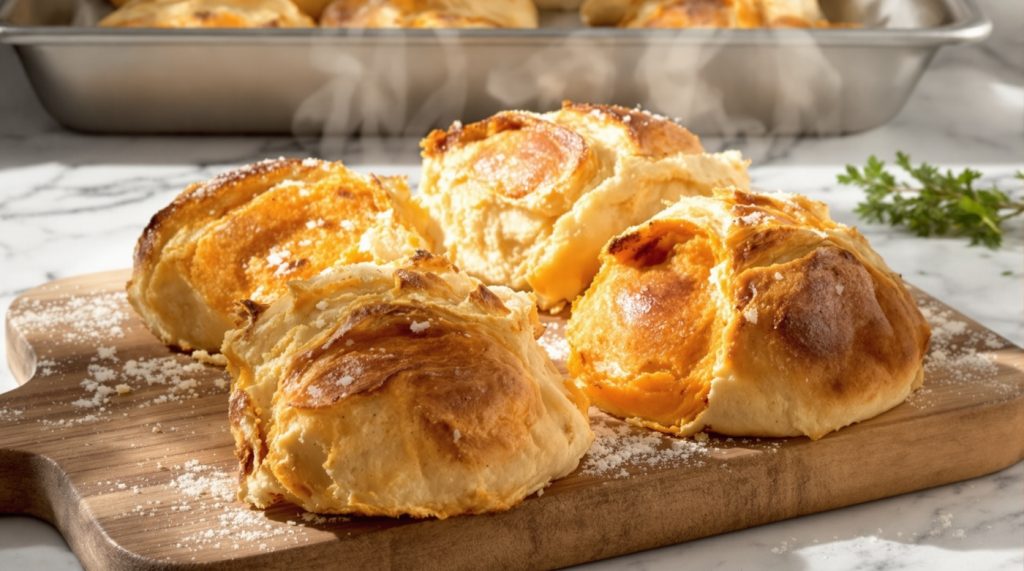
As you commence on the journey of baking sourdough sweet potato rolls, achieving perfection is within your reach with the right techniques and attention to detail.
Preheat your oven to 350°F or 400°F, depending on your recipe, ensuring it’s fully heated before you slide in the rolls.
Place your beautifully proofed rolls inside and bake for 22-25 minutes, or up to an hour, until they’re golden and fragrant. Keep a keen eye on them to avoid over-browning.
Once baked, brush the warm rolls with a luscious mix of melted butter, honey, and cinnamon for an irresistible finish.
Let them cool for at least 30 minutes, allowing the flavors to settle into pure perfection.
Serving and Storage Tips
After crafting your sourdough sweet potato rolls with care, let’s plunge into serving and storing them to maintain their delightful flavor and texture.
You’ve worked hard, so guarantee they shine at the table and stay fresh for days. Serve them warm with cinnamon butter or honey, paired with roasted meats or hearty fall soups.
For storage, keep them in an airtight container at room temperature for up to 5 days, or freeze in bags for a month.
Savor these tips for the best experience:
- Warm before serving: Reheat at 350°F for 10-15 minutes.
- Pair creatively: Try herb butter or local honey.
- Store smart: Avoid refrigeration to prevent staling.
- Freeze wisely: Cool completely first.
- Label clearly: Track freshness with dates.
Frequently Asked Questions
Can I Use Canned Sweet Potato Puree?
Hey, wondering if you can use canned sweet potato puree? Absolutely, you can, but tread carefully!
Its higher moisture might mess with your results, risking a wet, dense texture. You’ll need to adjust by adding extra flour gradually and maybe strain the puree to ditch excess liquid.
While it saves time, fresh-roasted puree often trumps in flavor and control.
How Do I Store Leftover Rolls?
Hey, let’s talk about storing leftover rolls to keep them fresh!
Store fully cooled rolls in an airtight container at room temperature for 2-3 days. Cool ‘em on a wire rack first to avoid condensation.
For longer storage, pop ‘em in a freezer-safe bag and freeze for up to a month. Thaw at room temp, then reheat in a 350°F oven for 10-15 minutes.
Can I Make These Rolls Vegan?
Hey, you can absolutely make your baked goods vegan with a few smart swaps!
Use a vegan sourdough starter, and switch out butter for plant-based options like coconut oil or margarine.
Replace milk with almond or soy milk, and use flaxseed or aquafaba instead of eggs.
Keep that sweet potato puree homemade for control.
You’ll nail a delicious vegan version with the same amazing flavor and texture.
What if My Starter Isn’T Active?
As the saying goes, “A stitch in time saves nine.”
If your starter isn’t active, don’t wait—act now! Check for hooch or bad odors, and reset with a 1:2:2 feeding ratio of starter, flour, and water.
Boost the temp to 70-75°F, switch to rye flour for kick, and discard excess. Feed daily, use warm water, and monitor rise.
Can I Bake Without a Thermometer?
Hey, you can absolutely bake without a thermometer! Trust your senses—look for a golden crust and tap for a hollow sound to gauge doneness.
Use the skewer test; it should come out clean. Stick to recipe times, preheat your oven properly, and watch for consistent results.
You’ve got this! With keen observation and a bit of practice, you’ll nail perfect bakes every time, no gadget needed.
Golden Rolls, Warm Souls
So, you’ve just crafted a batch of sourdough sweet potato rolls that are more than mere bread—they’re a warm embrace on a chilly day. Your kitchen’s now a sanctuary of comfort, each roll a proof of your skill and heart.
Savor this triumph, share the love, and stash any extras away. Trust me, these golden gems won’t linger long; they’re destined to disappear into happy bellies.

